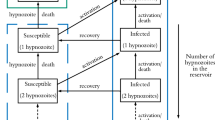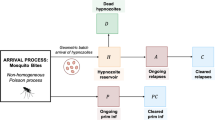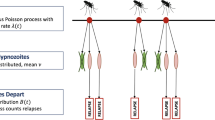Abstract
Malaria is an infectious disease with an immense global health burden. Plasmodium vivax is the most geographically widespread species of malaria. Relapsing infections, caused by the activation of liver-stage parasites known as hypnozoites, are a critical feature of the epidemiology of Plasmodium vivax. Hypnozoites remain dormant in the liver for weeks or months after inoculation, but cause relapsing infections upon activation. Here, we introduce a dynamic probability model of the activation-clearance process governing both potential relapses and the size of the hypnozoite reservoir. We begin by modelling activation-clearance dynamics for a single hypnozoite using a continuous-time Markov chain. We then extend our analysis to consider activation-clearance dynamics for a single mosquito bite, which can simultaneously establish multiple hypnozoites, under the assumption of independent hypnozoite behaviour. We derive analytic expressions for the time to first relapse and the time to hypnozoite clearance for mosquito bites establishing variable numbers of hypnozoites, both of which are quantities of epidemiological significance. Our results extend those in the literature, which were limited due to an assumption of collective dormancy. Our within-host model can be embedded readily in multiscale models and epidemiological frameworks, with analytic solutions increasing the tractability of statistical inference and analysis. Our work therefore provides a foundation for further work on immune development and epidemiological-scale analysis, both of which are important for achieving the goal of malaria elimination.










Similar content being viewed by others
References
Beier JC, Beier MS, Vaughan JEFFERSONA, Pumpuni CB, Davis JR, Noden BH (1992) Sporozite transmission by anopheles freeborni and anopheles gambiae experimentally infected with plasmodium falciparum. J Am Mosquito Control Assoc 8:404–404
Epstein B, Weissman I (2008) Mathematical models for systems reliability. Chapman and Hall/CRC, Boca Raton
Garira W (2018) A primer on multiscale modelling of infectious disease systems. Infect Dis Modell 3:176–191
Harrison JM, Lemoine AJ (1981) A note on networks of infinite-server queues. J Appl Probab 18(2):561–567
Howes RE, Battle KE, Mendis KN, Smith DL, Cibulskis RE, Kevin Baird J, Hay SI (2016) Global epidemiology of Plasmodium vivax. Am J Trop Med Hyg 95(6 Suppl):15–34
Hulden L, Hulden L (2011) Activation of the hypnozoite: a part of Plasmodium vivax life cycle and survival. Malaria J 10(1):90
Jeffrey A, Zwillinger D (2007) Table of integrals, series, and products. Elsevier, Amsterdam
Malato Y, Naqvi S, Schürmann N, Ng R, Wang B, Zape J, Kay MA, Grimm D, Willenbring H (2011) Fate tracing of mature hepatocytes in mouse liver homeostasis and regeneration. J Clin Investig 121(12):4850–4860
Mueller I, Galinski MR, Kevin Baird J, Carlton JM, Kochar DK, Alonso PL, del Portillo HA (2009) Key gaps in the knowledge of Plasmodium vivax, a neglected human malaria parasite. Lancet Infect Dis 9(9):555–566
Rankin KE, Graewe S, Heussler VT, Stanway RR (2010) Imaging liver-stage malaria parasites. Cell Microbiol 12(5):569–579
Sohlenius-Sternbeck AK (2006) Determination of the hepatocellularity number for human, dog, rabbit, rat and mouse livers from protein concentration measurements. Toxicol In Vitro 20(8):1582–1586
White, MT, Karl S, Battle KE, Hay SI, Mueller I, Ghani AC (2014) Modelling the contribution of the hypnozoite reservoir to Plasmodium vivax transmission. In: eLife 3, e04692
White, NJ, Imwong M (2012) Relapse. In: Advances in parasitology. Vol. 80. Elsevier, Amsterdam, pp 113–150
White NJ (2011) Determinants of relapse periodicity in Plasmodium vivax malaria. Malaria J 10(1):297
World Health Organisation (2017) World Malaria report 2017. ISBN 978 92 4 156552 3
Acknowledgements
S. Mehra acknowledges funding from the Australian Mathematical Sciences Institute (AMSI) Vacation Research Scholarships 2018/2019. J.M. McCaw’s research is supported by the Australian Research Council (ARC) Discovery Project DP170103076. J.A. Flegg’s research is supported by the ARC DECRA Fellowship DE160100227. P.G. Taylor’s research is supported by the ARC Laureate Fellowship FL130100039 and the ARC Centre of Excellence for the Mathematical and Statistical Frontiers (ACEMS).
Author information
Authors and Affiliations
Corresponding author
Additional information
Publisher's Note
Springer Nature remains neutral with regard to jurisdictional claims in published maps and institutional affiliations.
Electronic supplementary material
Below is the link to the electronic supplementary material.
Rights and permissions
About this article
Cite this article
Mehra, S., McCaw, J.M., Flegg, M.B. et al. An Activation-Clearance Model for Plasmodium vivax Malaria. Bull Math Biol 82, 32 (2020). https://doi.org/10.1007/s11538-020-00706-1
Received:
Accepted:
Published:
DOI: https://doi.org/10.1007/s11538-020-00706-1




